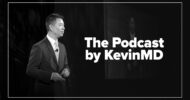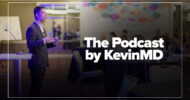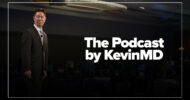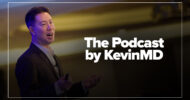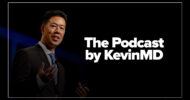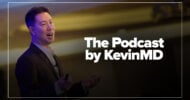Subscribe to The Podcast by KevinMD. Watch on YouTube. Catch up on old episodes!
We dive into the persistent challenge of fall prevention in hospitals with our guest, Christine Gall, a nurse executive. Despite advancements in patient safety, falls remain a significant issue, resulting in severe injuries and even death. We explore why traditional prevention strategies often fail, the staggering human and financial costs of falls, and how innovative solutions like virtual monitoring can make a difference. Christine shares her insights on data-driven approaches, the role of technology, and what health care leaders can do to create safer environments for patients, especially as the aging population grows.
Christine Gall is a nurse executive.
She discusses the KevinMD article, “Embracing data-driven solutions to prevent falls.”
Our presenting sponsor is DAX Copilot by Microsoft.
Do you spend more time on administrative tasks like clinical documentation than you do with patients? You’re not alone. Clinicians report spending up to two hours on administrative tasks for each hour of patient care. Microsoft is committed to helping clinicians restore the balance with DAX Copilot, an AI-powered, voice-enabled solution that automates clinical documentation and workflows.
70 percent of physicians who use DAX Copilot say it improves their work-life balance while reducing feelings of burnout and fatigue. Patients love it too! 93 percent of patients say their physician is more personable and conversational, and 75 percent of physicians say it improves patient experiences.
Help restore your work-life balance with DAX Copilot, your AI assistant for automated clinical documentation and workflows.
VISIT SPONSOR → https://aka.ms/kevinmd
SUBSCRIBE TO THE PODCAST → https://kevinmd.com/podcast
RECOMMENDED BY KEVINMD → https://kevinmd.com/recommended
GET CME FOR THIS EPISODE → https://kevinmd.com/cme
I’m partnering with Learner+ to offer clinicians access to an AI-powered reflective portfolio that rewards CME/CE credits from meaningful reflections. Find out more: https://kevinmd.com/learnerplus
Transcript
Kevin Pho: Hi, and welcome to the show. Subscribe at KevinMD.com/podcast. Today, we welcome Christine Gall. She’s a nurse executive. Today’s KevinMD article is “Embracing Data-Driven Solutions to Prevent Falls.” Christine, welcome to the show.
Christine Gall: Kevin, thanks so much for having me.
Kevin Pho: So, let’s start by briefly sharing your story and journey.
Christine Gall: Well, I started out as a pediatric nurse here in southeast Wisconsin at Children’s Wisconsin. And, you know, very quickly, I recognized that I wanted to do other things. My career is really based on the promise of curiosity. I’ve always wanted to learn more and try and impact the challenges of the day.
So, I’ve done everything from clinically starting out in pediatric cardiac care and step-down care. I have had the great opportunity to have leadership positions, develop programs from concept to implementation, and have really enjoyed that whole inquiry. I pivoted into patient experience as well, spending about 10 years doing benchmarking for a national database for pediatric critical care. So, throughout my journey, I’ve always wanted to explore deeper where we could impact and influence the delivery of care differently to improve outcomes for patients.
Kevin Pho: Perfect. In today’s episode, we’re going to talk specifically about falls. Your KevinMD article is titled, “Embracing Data-Driven Solutions to Prevent Falls.” Now, what led you to write this article in the first place? And then, talk about the article itself for those who didn’t get a chance to read it.
Christine Gall: Yeah, well, you know, I’ll tell you, we had a landmark article or a book come out called To Err Is Human almost 25 years ago now, and we still haven’t solved patient safety. When you look at fall rates across the United States, and recognizing that, although I started out in pediatrics, I am now laser-focused on what’s happening to our citizens at the end of life.
I have a front-row seat to my own parents as they age. And what I have seen in the data and literature supports this: falls actually more often than not are the final situation that occurs, leading to that inevitable final decline in life. I think it’s something that we have to pay attention to. There are so many issues that we have to deal with in health care that are actually challenging our ability to continue to focus on falls as a leading issue for us. So, I think it’s an area that we need to continue to keep at the top of our conversations professionally and collaborate in new and innovative ways for how we can impact this really important issue.
Kevin Pho: And for those who may not be familiar with the severity of falls, and like you said, how that could potentially lead to a final decline in a health care setting, what are some of the major reasons? What are some of the key factors that lead to falls in the first place?
Christine Gall: Yeah, great question. You know, when we look at the environment of a hospital, it is a very foreign environment for people in general. It’s an intimidating environment. And when you are in a hospital, being ill and dependent upon the system and the people around you, it’s a really challenging place to be. Add on top of that things that include injury or illness that might have impacted your strength or your ability to troubleshoot problems, or just cognitive cognition in general.
Add on top of that the medications that might be used to treat you, which might impact your ability to be independent. And then, add on top of that, if you are in the later stages of life, and you might have the early onset or impact of your cognition through dementia or other factors, you are going to be at a very great risk while in the hospital environment, seeking care to improve your outcomes.
By design, it’s putting you in a challenging position. On top of that, you have the challenge of our workforce, and this is not exclusive to health care, but health care is really challenged by the fact that we have people leaving at greater numbers than ever seen or anticipated lately, and we don’t have enough newer people entering the profession to be able to impact the void that has been created.
So, when you’re dealing with issues related to patient safety and the programs that are developed to address patient safety issues like falls, it requires humans on the other end of the equation. When you are stressed and taxed, and your nurse-to-patient ratio, as an example, is increasing, your ability to do all of those things—in addition to all of the orders and tasks and the assessments needed to ensure that the patient continues to heal—all becomes a challenge.
Kevin Pho: Now, what are some of the traditional measures that health care institutions use to prevent falls? And why do you think, despite these measures, the challenge of falls continues to persist today?
Christine Gall: Well, clearly, throughout my career, we have tried many things. And, as I mentioned, I started out in pediatrics, so I had to catch up when I entered the field of adult patient care and very quickly recognized the challenges. There are everything from monitors to bed alarms to sitters who sit one-on-one with patients at the bedside.
There are reminders—visual reminders—that ask people to use their call light instead of attempting to do something independently. All of the above. And the challenge is that we still don’t have the right mixture of solutions that address that patient where they are and what their experience of care is.
When I think about when I made the transition from pediatric to adult care, and people would ask me, “How on earth did you take care of children who are fragile, sick, and dying?” And what was very challenging for me when I would start walking the halls of facilities that took care of adults is I would look around and see the humanness in every bed and the fact that, you know, every person that I looked at was losing some of their independence and their milestones and even their basic human dignities at times.
And I think, you know, we need to really think about how we deliver care. Is an alarm that sounds every time a patient moves in their bed the right and best solution? Or are there other alternatives? And really, that’s what attracted me to Colette Health. When you can actually have a person who is dedicated to interacting and connecting with a patient to keep them safe, to make sure that they are continually supported and listened to, and even sometimes redirected when some of their activities might be leading down a path that could cause them an injury or a fall—those are the things that I think are really important to maintaining a safe environment while protecting the dignity of our patients.
So, I think that human factor of virtual care is so very important, and I think it’s something that is really gaining a lot of attention. So, conversations like this that we’re having are so very important.
Kevin Pho: So, let’s talk more specifically about that. Your KevinMD article talks about some of these technological and data-driven solutions, and you alluded to the virtual aspect of that. So, go into more detail about some of the potential solutions you have to prevent falls.
Christine Gall: We started out in our journey of virtual care very much like our customer colleagues entered virtual care—through direct patient observation. And that is, you have an observer who’s not physically located in the same place as the patient being able to observe not just one patient as our one-on-one sitter option does, but engage with multiple patients simultaneously.
Some of the features that enable them to do that well are some AI technologies built into the platform that include things like motion detection. So, if you are watching a panel of, let’s say, 10 or 12 patients as an observer, you can actually—if you think about them as “Brady Bunch” tiles or much like a Zoom video where you have lots of screens with different people in the different tiles—move them around so that the most active patients are directly within your line of sight. But those patients who are sleeping, whom you might move to more of the periphery of your screen, they need attention too.
And in fact, when patients awaken, that’s actually one of the most at-risk periods of time. So, we have technology, as an example, that recognizes when someone is beginning to awaken. It alerts the observer by highlighting that tile and saying, “Hey, you’ll want to pay attention here.”
When that observer has been armed with information through shift reports from that bedside nurse who’s physically there, they might say, “You know what? This patient wakes up usually confused.” They can very quickly engage with that patient when they awaken: “Mr. Jones, how was your sleep? Did you have a good nap? I want to remind you that you’re in the hospital. How are you doing right now? Do you need anything? I’d love to be able to connect with your nurse or nursing assistant if you need anything.”
That is a really subtle but, again, a respectful way of supporting that patient, reorienting them to their environment, ensuring them, and giving them the peace of mind that there’s somebody there for them. And I think that’s one aspect of care.
But going beyond observation, we recognize that there are other aspects of care. One of the challenges health care is dealing with is that as our senior nurses leave—those with that great tenure and expertise—they’re also taking their knowledge with them. Because the challenges of bedside care have become incredibly rigorous, particularly in the last three or four years, what can we do to leverage that expertise by offering nurses who say, “I just can’t manage the rigor of bedside care anymore”?
Let’s give them a different career path. I’m having dozens of conversations across the country about how we can provide a different career path. Let those expert nurses who have so much more to give have an opportunity to, number one, mentor their nurses who are following in their footsteps, give them expert guidance, or even offload some of the challenging aspects of care.
When you look at care, there’s the admission process and the discharge process. Those are two very high-effort, energy, and expertise-requiring aspects of care. Let someone who is a team member of that bedside nurse help them with the education that’s needed, the collaboration, or the coordination of care that’s required. Let someone who is a virtual support to that bedside nurse do that.
So, virtual nursing is another area of care that definitely, you know, we are positioned to support. But it’s not just the technology that can do everything. You have to have the programs and the leadership support wrapped around the technology to leverage it at its best. So, the programmatic aspects of implementing virtual nursing and virtual observation are just as important as the technology.
Kevin Pho: With your virtual observation platform, of course, there’s going to be AI algorithms, but also someone monitoring up to, you said, 10 patients at a time. What are some of the things that they would specifically observe? And you mentioned that just a patient getting up puts them at risk for falls, but what are some other things that they could observe that would perhaps warn the bedside nurse that this patient is a particularly high fall risk? What are some of the things that your virtual platform is specifically looking for?
Christine Gall: Yeah, so definitely the observer is cued in, starting with the information they get from the bedside nurse at shift report, on what their areas of particular challenge are. So, it may start with agitation. It may start with knowing that that patient got a diuretic 30 minutes ago. So, guess what? They’re probably going to need to go to the bathroom sometime soon.
Being able to check in with that patient again—that human contact—checking in so that they don’t make that urgent dash to the bathroom because they do not want the undignified impact of incontinence. That’s something I think we can all relate to.
So, we look at that. There are also technology aspects, including things like third-party join, which means that in addition to the observer, another party can come into that room virtually. So, maybe the issue for that patient is they are beyond consolable, and the only person they need is their spouse right now. You can bring their spouse into the room. You can bring whoever their representative is—the person who helps them navigate care.
If they’re confused about the choices they have—there are many things that can make somebody either need to get up because they want to be independent (and that has so many different triggers) or they’ve had enough and are out of there, and elopement becomes an issue. Obviously, that can lead to a fall.
So, understanding a patient, developing those human connections beyond what the bedside nurse, through their episodic interactions in the room, is able to do—because of the other demands they have—having a virtual companion in that room who is cued into the specific needs of a patient can emotionally support them, recognize when something is accelerating, and bring the right resources into the room, whether it’s someone directly at the hospital or virtually someone who can help address their questions, their concerns, or just give them support in the form of a family member.
Kevin Pho: So very important. Now, is there any data that shows that a virtual monitoring platform like this has led to a decrease in patient falls?
Christine Gall: You know, I’m very proud to say that throughout our customer base in the last 12 months, we have prevented just under 100,000 falls. Our good catches in other areas—where we have prevented injury or improved the care team’s ability to take care of issues specific to a patient—are innumerable.
So, you know, it works. We know that the technology works. But again, it’s not just a platform. It’s not about the technology. It’s about savvy leadership and savvy implementation of that platform, the technology, and making sure that the staff on the unit are trusting and willing to lean in to adopt the technology. Because without that part of the equation, we all know those closets or those drawers on every unit with the latest, best idea that got shelved or put in the closet because nobody wanted to deal with it.
That’s truly, I think, the difference that Colette Health brings to the table. We want to be the implementation partner, not just sell you something and walk away. Because in order to deal with patient falls, which is one of our top priorities, we need to make sure that the systems in place and the leadership in place around that technology are agile, efficient, and effective.
Kevin Pho: We’re talking to Christine Gall. She’s a nurse executive. Today’s KevinMD article is “Embracing Data-Driven Solutions to Prevent Falls.” Christine, we’ll end with some of your take-home messages that you want to leave with the KevinMD audience.
Christine Gall: Oh, well, thanks, Kevin, again, for allowing me to be here. I think we are in a period of time in health care that I’ve never seen before. This is our opportunity. We have the acceleration and interest to bring virtual technology into patient care. We need to do that in a thoughtful manner.
We also need to prepare our leaders to be able to lead in this new frontier of virtual care, and how and when you actually incorporate virtual aspects of care into the delivery of human-centered patient care to improve outcomes, safety, and the experience of care for both clinicians and patients. We also need to look at—this isn’t a cookie-cutter solution. We need to look at what the major problems are, what the major challenges of your particular population are, and address them through custom purpose-built programs that best leverage the technology available.
So, I’d like to leave you with this: when you choose your partners, we’re all looking at who we want to partner with to address these problems and bring virtual care in. Make sure that who you choose not only has the technology part of the equation, but also has the leadership and the programmatic chops to be able to help you execute a program and bring the staff to a place where they are ready, willing, and able to adopt that new change in their workflow to improve the outcomes that are obviously desired from virtual care.
Kevin Pho: Christine, thank you so much for sharing your perspective and insight. Thanks again for coming on the show.
Christine Gall: Kevin, thanks so much.









